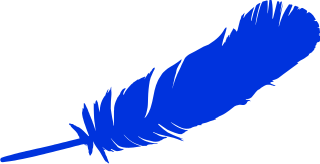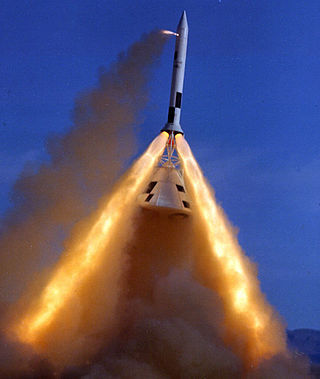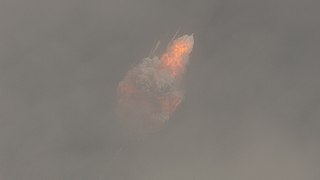Related Research Articles
Human spaceflight programs have been conducted, started, or planned by multiple countries and companies. The age of crewed rocket flight was initiated by Fritz von Opel who piloted the world's first rocket-propelled flight on 30 September 1929. All space flights depend on rocket technology; von Opel was the co-designer and financier of the visionary project. Until the 21st century, human spaceflight programs were sponsored exclusively by governments, through either the military or civilian space agencies. With the launch of the privately funded SpaceShipOne in 2004, a new category of human spaceflight programs – commercial human spaceflight – arrived. By the end of 2022, three countries and one private company (SpaceX) had successfully launched humans to Earth orbit, and two private companies had launched humans on a suborbital trajectory.

A reusable launch vehicle has parts that can be recovered and reflown, while carrying payloads from the surface to outer space. Rocket stages are the most common launch vehicle parts aimed for reuse. Smaller parts such as rocket engines and boosters can also be reused, though reusable spacecraft may be launched on top of an expendable launch vehicle. Reusable launch vehicles do not need to make these parts for each launch, therefore reducing its launch cost significantly. However, these benefits are diminished by the cost of recovery and refurbishment.

Blue Origin Enterprises, L.P. is an American aerospace manufacturer, defense contractor, launch service provider and space technologies company headquartered in Kent, Washington, United States. The company makes rocket engines for United Launch Alliance (ULA) and manufactures their own rockets, spacecraft, satellites, and heavy-lift launch vehicles. The company is the second provider of lunar lander services for NASA's Artemis program and was awarded a $3.4 billion contract. The company has four rocket engines in production including the BE-3U, BE-3PM, BE-4 and the BE-7.

A launch escape system (LES) or launch abort system (LAS) is a crew-safety system connected to a space capsule. It is used in the event of a critical emergency to quickly separate the capsule from its launch vehicle in case of an emergency requiring the abort of the launch, such as an impending explosion. The LES is typically controlled by a combination of automatic rocket failure detection, and a manual activation for the crew commander's use. The LES may be used while the launch vehicle is still on the launch pad, or during its ascent. Such systems are usually of three types:

New Shepard is a fully reusable sub-orbital launch vehicle developed for space tourism by Blue Origin. The vehicle is named after Alan Shepard, who became the first American to travel into space and the fifth person to walk on the Moon. The vehicle is capable of vertical takeoff and landings. Additionally, it is also capable of carrying humans and customer payloads into a sub-orbital trajectory.

Gaganyaan is an Indian crewed orbital spacecraft intended to be the formative spacecraft of the Indian Human Spaceflight Programme. The spacecraft is being designed to carry three people, and a planned upgraded version will be equipped with rendezvous and docking capabilities. In its maiden crewed mission, the Indian Space Research Organisation (ISRO)'s largely autonomous 5.3-metric ton capsule will orbit the Earth at 400 km altitude for up to seven days with a two- or three-person crew on board. The first crewed mission was originally planned to be launched on ISRO's LVM3 rocket in December 2021. As of October 2023, it is expected to be launched by 2025.

Launch vehicle system tests assess the readiness of a launch system to safely reach orbit. Launch vehicles undergo system tests before they launch. Wet dress rehearsals (WDR) and more extensive static fire tests prepare fully assembled launch vehicles and their associated ground support equipment (GSE) prior to launch. The spacecraft/payload may or may not be attached to the launch vehicle during the WDR or static fire, but sufficient elements of the rocket and all relevant ground support equipment are in place to help verify that the rocket is ready for flight.

Soyuz MS-10 was a crewed Soyuz MS spaceflight that aborted shortly after launch on 11 October 2018 due to a failure of the Soyuz-FG launch vehicle boosters. MS-10 was the 139th flight of a Soyuz spacecraft. It was intended to transport two members of the Expedition 57 crew to the International Space Station. A few minutes after liftoff, the craft went into contingency abort due to a booster failure and had to return to Earth. By the time the contingency abort was declared, the launch escape system (LES) tower had already been ejected and the capsule was pulled away from the rocket using the solid rocket jettison motors on the capsule fairing. Both crew members, Roscosmos cosmonaut Aleksey Ovchinin and NASA astronaut Nick Hague, were recovered in good health. The MS-10 flight abort was the first instance of a Russian crewed booster accident in 35 years, since Soyuz T-10-1 exploded on the launch pad in September 1983. On 1 November 2018, Russian scientists released a video recording of the mission.

The Artemis program is a Moon exploration program that is led by the United States' NASA and formally established in 2017 via Space Policy Directive 1. The Artemis program is intended to reestablish a human presence on the Moon for the first time since Apollo 17 in 1972. The program's stated long-term goal is to establish a permanent base on the Moon to facilitate human missions to Mars.

SpaceXCrew Dragon In-Flight Abort Test was a successful test of the SpaceX Dragon 2 abort system, conducted on 19 January 2020. It was the final assessment for the Crew Dragon capsule and Falcon 9 launch system before they would be certified to carry humans into space. Booster B1046.4 and an uncrewed capsule C205 were launched from Launch Complex 39A (LC-39A) on a suborbital trajectory, followed by an in-flight abort of the capsule at max Q and supersonic speed. The test was carried out successfully: the capsule pulled itself away from the booster after launch control commanded the abort, and landed safely.

Blue Origin NS-16 was a sub-orbital spaceflight mission operated by Blue Origin which flew on 20 July 2021. The mission was the sixteenth flight of the company's New Shepard integrated launch vehicle and spacecraft, and its first crewed flight. It carried into space American billionaire and Blue Origin founder Jeff Bezos, his brother Mark, pilot and Mercury 13 member Wally Funk, and Dutch student Oliver Daemen. The flight commenced from Blue Origin's Corn Ranch sub-orbital launch site in West Texas aboard the third flight of New Shepard booster NS4 and the spacecraft RSS First Step, both having previously flown on NS-14 and NS-15 earlier in the year.
RSS First Step is a New Shepard space capsule, built and operated by American spaceflight company Blue Origin. It is the third New Shepard capsule to fly to space, and the first to fly passengers. Its first flight was the NS-14 mission, which reached an altitude of 107 km (66 mi) on 14 January 2021.

Blue Origin NS-19 was a crewed New Shepard sub-orbital spaceflight mission operated by Blue Origin that launched on 11 December 2021. The flight was scheduled to launch on 9 December 2021, later delayed to 11 December 2021.
Blue Origin NS-23 was an uncrewed sub-orbital spaceflight mission of Blue Origin's New Shepard rocket, which launched on 12 September 2022. The booster failed during max q about a minute after launch, triggering the launch escape system which removed the capsule from the booster. The capsule landed successfully, while the booster was destroyed upon impact with the ground.
Gary Lai is an American aerospace engineer. He was the chief architect for New Shepard, a vehicle developed by aerospace manufacturer Blue Origin for space tourism. On March 31, 2022, he flew on New Shepard's 20th mission to space, NS-20. He is a Co-Founder and the Chief Technology Officer of a company called Interlune.
Blue Origin NS-24 was an uncrewed sub-orbital spaceflight mission of Blue Origin's New Shepard rocket, which launched on 20 December 2023. It was New Shepards first flight in over a year since the failure of Blue Origin NS-23. It was Blue Origin's 24th overall flight to go into space.
Blue Origin NS-17 was an uncrewed sub-orbital spaceflight mission of Blue Origin's New Shepard rocket, which launched on 26 August 2021. It was New Shepards 4th flight in 2021. It was also Blue Origin's 17th overall flight to go into space.
References
- ↑ Replay - New Shepard Mission NS-15 Webcast , retrieved 2024-01-12
- ↑ "Blue Origin Conducts Astronaut Rehearsal for Future Customer Flights". Blue Origin. Retrieved 2024-01-12.
- ↑ "Blue Origin Conducts Astronaut Rehearsal for Future Customer Flights". Blue Origin. Retrieved 2024-01-12.
- ↑ updated, Meghan Bartels last (2021-04-14). "Blue Origin aces 'astronaut rehearsal' New Shepard test flight". Space.com. Retrieved 2024-01-12.
- ↑ Gebhardt, Chris (2021-04-14). "Blue Origin succeeds in 15th New Shepard flight, critical test before carrying humans". NASASpaceFlight.com. Retrieved 2024-01-12.
- ↑ updated, Meghan Bartels last (2021-04-14). "Blue Origin aces 'astronaut rehearsal' New Shepard test flight". Space.com. Retrieved 2024-01-12.
- ↑ Gebhardt, Chris (2021-04-14). "Blue Origin succeeds in 15th New Shepard flight, critical test before carrying humans". NASASpaceFlight.com. Retrieved 2024-01-12.
- ↑ "Blue Origin Conducts Astronaut Rehearsal for Future Customer Flights". Blue Origin. Retrieved 2024-01-12.
- ↑ Replay - New Shepard Mission NS-15 Webcast , retrieved 2024-01-12